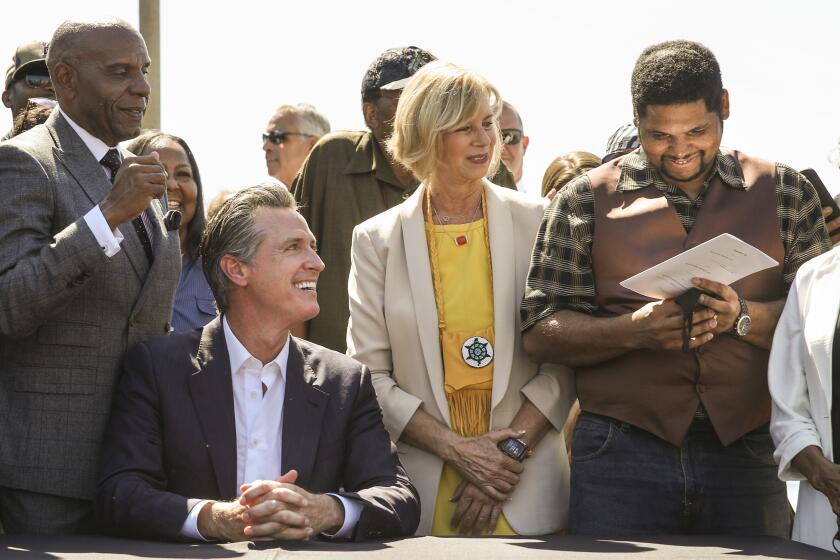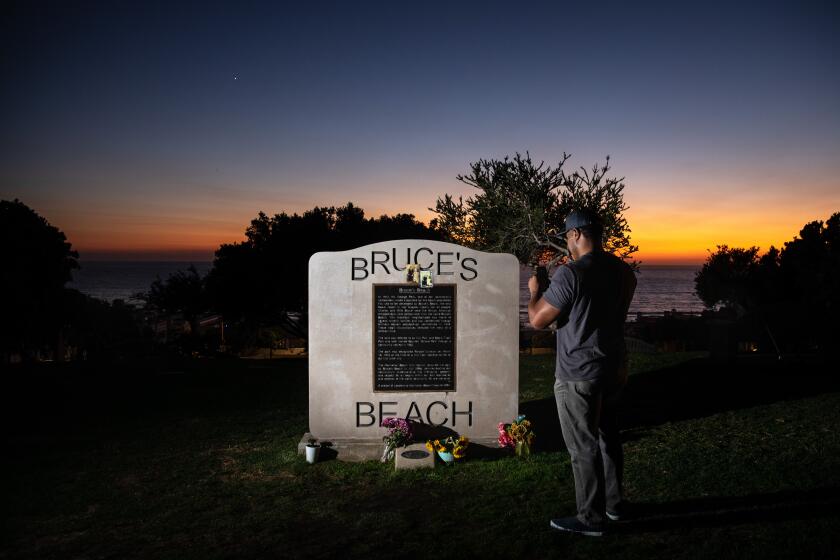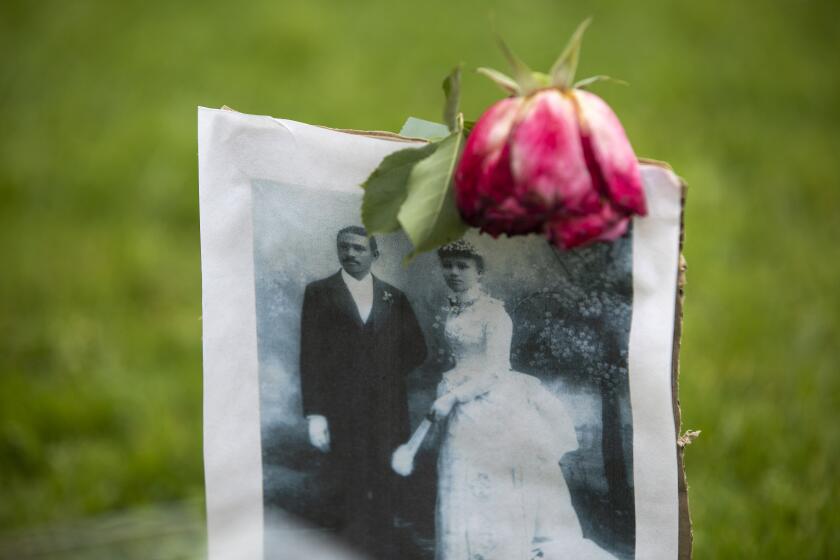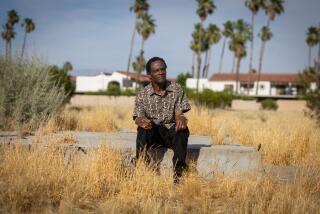‘We are finally here’: Plan to return Bruce’s Beach wins unanimous approval
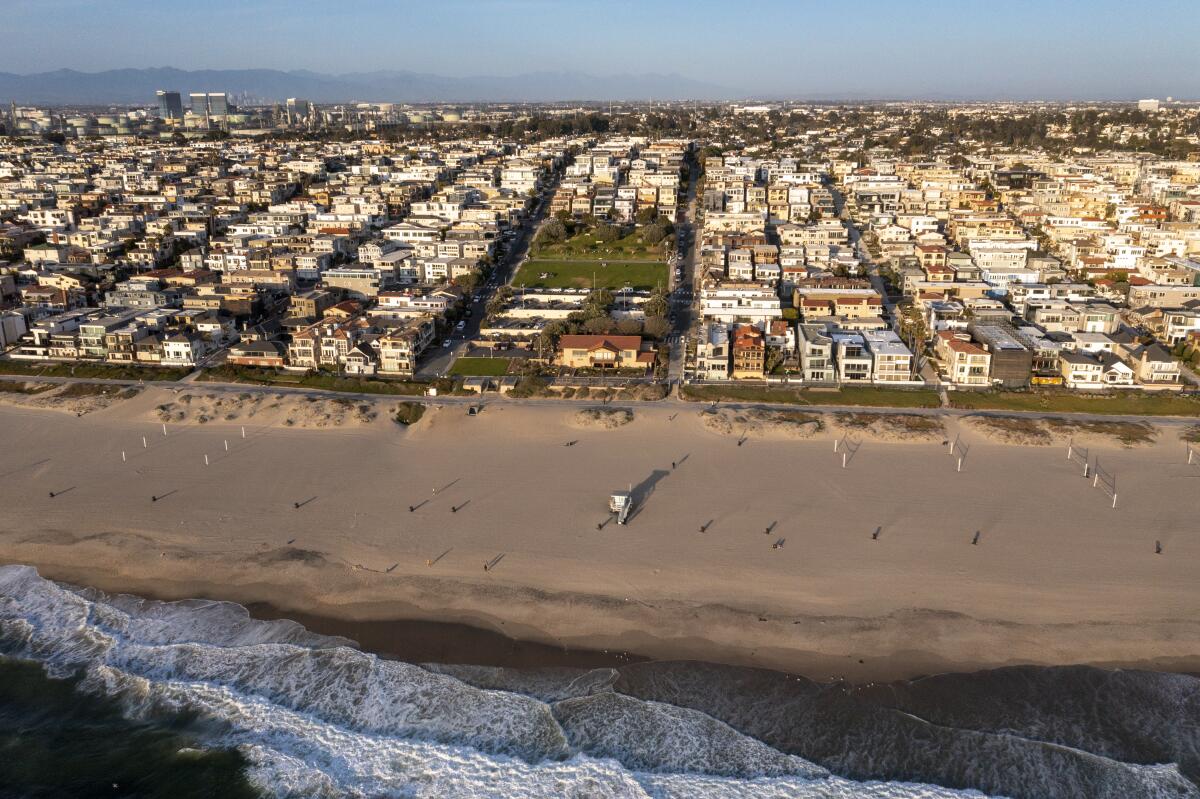
- Share via
The Los Angeles County Board of Supervisors unanimously approved an unprecedented plan to return Bruce’s Beach to a Black family that had been run out of Manhattan Beach almost a century ago — paving the way for more efforts by the government to rectify historic injustices that were racially motivated.
In a heartfelt moment during the board meeting Tuesday, Supervisor Janice Hahn reflected on all the legal, legislative and very complicated real estate details that had to be worked out to right a wrong that had sparked a movement and captivated the country.
“We are finally here today,” said Hahn, who launched the complex process more than a year ago. “We can’t change the past, and we will never be able to make up for the injustice that was done to Willa and Charles Bruce a century ago. But this is a start, and it is the right thing to do.”
The property will now enter escrow before officially transferring to the Bruce family. After it’s transferred, the county has agreed to rent the property from the Bruces for $413,000 a year and will maintain its lifeguard facility there.
The lease agreement also includes a right for the county to purchase the land at a later date for $20 million, plus any associated transaction costs.
In a public address to the board, George Fatheree, a real estate transaction lawyer who has been representing the Bruce family pro bono, thanked the many county leaders and staff “who have worked tirelessly to get to this point today … who approached this work with thoughtfulness, care, diligence, creativity and, above all, a commitment to doing the right thing.”
“To our knowledge, this is the first time the government has returned property to a Black family after acknowledging it had been improperly taken,” he said. “We’re hopeful that it will not be the last.”
In a detailed plan made public for the first time, Los Angeles County officials have spelled out how the Bruce’s Beach transfer will occur.
The return of Bruce’s Beach has forged a helpful path forward for other cities and states seeking to atone for past injustices. Many point to the country’s history of violently dispossessing Indigenous people and displacing entire communities of color from prime real estate.
Tuesday’s decisive action demonstrates what is possible when the political will exists — and when the public insists on accountability, said Effie Turnbull Sanders, who has spent more than 20 years advancing the rights of underserved communities and currently serves as the California Coastal Commission’s environmental justice commissioner.
“We see now, with the example of Bruce’s Beach, that if we want to as a society, we can find a legal way to effect justice,” she said. “We can find a way to ensure that we don’t continue to perpetuate the structural inequalities that have existed for centuries in this country.”
Before Manhattan Beach shut it down, Bruce’s Beach was a famous Black-owned beach resort. Now, some want the city to atone for its actions.
The story of Bruce’s Beach starts with the Tongva people, who tended this stretch of coast for millenniums before white developers staked their claim in the early 1900s and built what is known today as Manhattan Beach.
By 1912, Charles and Willa Bruce had made their way to California. Willa purchased two lots right by the sand and ran a popular lodge, cafe and dance hall that extended a rare welcome to Black beachgoers. A few more Black families, drawn to this new neighborhood that became known as Bruce’s Beach, bought and built their own cottages by the sea.
But the Bruces and their guests faced increasing threats from white neighbors. The Ku Klux Klan and local real estate agents purportedly plotted ways to harass them.
When racism failed to drive this Black beach community out of town, city officials in 1924 condemned the neighborhood and seized more than two dozen properties through eminent domain. They said there was an urgent need for a public park.
But for decades, the properties sat empty. The two oceanfront parcels that had been owned by the Bruces were transferred to the state in 1948, then to the county in 1995. As for the other lots, city officials eventually turned them into a pretty park overlooking the ocean.
Gov. Gavin Newsom has authorized the return of property known as Bruce’s Beach to the descendants of a Black couple that had been run out of Manhattan Beach almost a century ago. Catch up on The Times’ coverage.
When Hahn realized that the county now owned the two parcels where the Bruce resort once stood, she jumped into action. She joined forces with Supervisor Holly Mitchell and state Sen. Steven Bradford (D-Gardena), who rallied state lawmakers and the governor to authorize transferring the public property back to private ownership.
A county team led by Thomas Faughnan and D’Artagnan Scorza, working with Fatheree, went through a complicated appraisal and economic analysis to determine the value of the property. They also conducted lengthy genealogy studies. (More than 100 people went through the county’s legal heir determination process to check whether they were related to Charles and Willa Bruce.)
Mitchell, chair of the Board of Supervisors, gathered everyone to sign the paperwork right after the vote so that there would be no further delay in returning the property. She also stressed that the county’s efforts to undo past injustices cannot end at Bruce’s Beach.
“I intentionally emphasize the word ‘return,’” said Mitchell, whose office has been working with the Bruce family and a committee to place a sign at the property detailing the history of what happened. “Because we aren’t giving property to anyone today. We are returning property that was erroneously taken from the Bruces based on fear and hate.... I intend to continue to lock arms with my elected colleagues to address … all forms of systemic racism that continue to plague American society.”
Kavon Ward, who has championed this cause through her grass-roots movement Justice for Bruce’s Beach, echoed this sentiment and said more government leaders need to step up and ensure that Bruce’s Beach is not a one-off.
“I’m relying on the governor to set an example and do the right thing in the state of California so that other states can replicate the successes,” said Ward, who has been helping five other Black California families in Santa Monica, Palm Springs, Coloma, Hayward and Canyon with stories similar to the Bruces’. “Pulling one family aside and not helping the rest is not setting a good example.”
Across California, reparations advocates and Indigenous leaders also welcomed the news but emphasized that there is a lot more history to unwind.
“There is a long legacy of colonial injustice, and this is a great first step to making reparations for this community. I really hope that other communities — including the local Indigenous communities of the Tongva, Acjachemen and Tataviam — will also be considered for future return of our ancestral lands,” said Wallace Cleaves, who has been navigating similar uncharted challenges in land return as president of the Tongva Taraxat Paxaavxa Conservancy.
Angela Mooney D’Arcy, who heads Sacred Places Institute for Indigenous Peoples, a grass-roots group led by native people in California, said her organization supported bringing justice to the Bruce family, and called on officials to include local Indigenous communities who have been left out.
“It’s critically important that in your act of taking on this momentous issue, you’re not inadvertently perpetuating the erasure of another community that has also suffered great injustices at the hands of white supremacist, institutionally racist culture,” she said, emphasizing that these issues “must be addressed in an intentional and thoughtful manner as there can be no healing if healing for one community rests on the erasure of another community.”
In a letter to the county, she asked officials to specify in their records that Bruce’s Beach is in the ancestral homelands of the Gabrielino Tongva people. She also urged county officials to develop a process to meet with local Indigenous leaders and to form a task force “to identify, examine and assess the ways in which current and future County-led efforts to bring about racial justice and healing can better inform, support and complement one another.”
The return of my family’s land will let us do what countless American families have done since our country’s founding: inherit property and build wealth.
For Anthony Bruce, the great-great-grandson of Charles and Willa Bruce, the last two years have been a jumble of emotions.
What Manhattan Beach did almost a century ago tore his family apart. Charles and Willa ended up as chefs serving other business owners for the remainder of their lives. His grandfather Bernard, born a few years after his family had been run out of town, was obsessed with what happened and lived his life “extremely angry at the world.” Bruce’s father, tormented by this history, had to leave California.
Bruce, a security supervisor in Florida, was thrust into the spotlight after Bruce’s Beach became a national story. It has been painful for him to talk publicly about his family’s history, but he has been heartened to see the growing movement of people calling for justice.
“Many families across the United States have been forced away from their homes and lands,” he said. “I hope that these monumental events encourage such families to keep trusting and believing that they will one day have what they deserve. We hope that our country no longer accepts prejudice as an acceptable behavior, and we need to stand united against it, because it has no place in our society today.”
More to Read
Sign up for Essential California
The most important California stories and recommendations in your inbox every morning.
You may occasionally receive promotional content from the Los Angeles Times.
